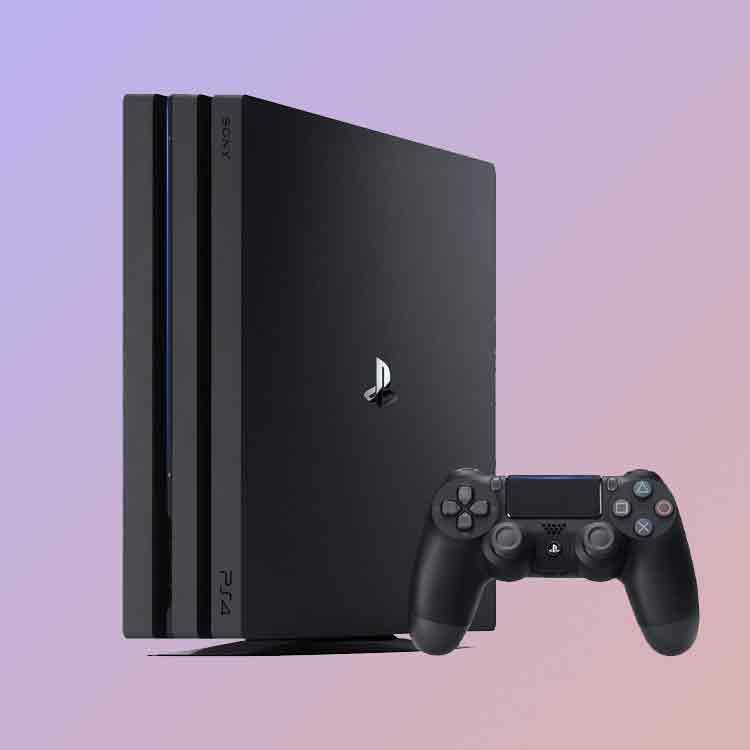-
Sony PlayStation 5
The PlayStation 5 streaks ahead where power is concerned but is a good chunk more expensive, unsurprisingly. Still, it’ll play basically every PS4 game as well as a newer library.
-

PlayStation 4 Pro
The PS4 Pro is still an impressive bit of kit, but it’s outstripped technically and is a way louder and more ponderous console, despite an undeniably excellent roster of game to explore.
The PlayStation 5 is available in both standard and Digital Editions, and, as you can find out in our in-depth review, it’s a true beast of a machine.
But is that enough to get you to cough up a fair penny to upgrade from a PS4 or PS4 Pro? And, if you’re only just considering a PlayStation for the first time, which will be best suited to your needs and budget?
We’ll answer those questions right here.
Specs and availability
These two consoles look nothing alike, as we’ll cover when we come to their respective designs, but the easiest way to check out their differences is by running your eye down a comparison table.
-
Sony PlayStation 5 PlayStation 4 Pro 4K Capability Yes Yes Game support PS5, PSVR 2, PS4, PSVR PS4, PSVR Storage 825GB SSD 1TB HDD CPU x86-64-AMD Ryzen Zen 8 cores x86-64 AMD Jaguar 8 cores Dimensions 390 × 260 × 104 mm 53 x 305 x 275 mm Weight 3.9 kg 3.3 kg RAM 16GB GDDR6 8GB GDDR5
Design
Both the PS4 and PS4 Pro have a similar design aesthetic – like a console-flavoured sandwich. The Pro is fatter, but they each sit in a similar footprint in your AV cabinet.
The PlayStation 5, on the other hand, is mammoth – considerably taller and heavier than either PS4. It also looks different, with white elements and a form factor that looks far better standing on its end than laid flat. It has faceplates on either side and will be trickier to cram into an average TV cabinet or stand.
But its size isn’t just aesthetic. The faceplates hide an enormous fan and vacuumable dust ports. More powerful processing usually comes at the cost of cooling, so the PS5 is designed that way to keep it as cool as possible. Certainly, from our experience, it’s incomparably quieter than either PS4 model, which are hugely loud.
In particular, our PS4 Pro sounds like a helicopter taking off these days, it runs so hot.
Processing and graphics
Naturally, the PS5 represents a next-generational leap in tech, so the processing unit and GPU are significantly more advanced than the ones used in the PS4 models.
All three consoles – base PS4, PS4 Pro and PS5 – use custom AMD CPUs, but the processing potential greatly improves as you move up the family.
Both the PS4 and PS4 Pro sport the same octa-core x86-64 AMD “Jaguar” chipset, while the PlayStation 5 adopts a much more recently crafted processor modelled on AMD’s octa-core Zen 2 design. It runs at 3.5GHz per core for starters, which makes it a heck of a lot faster than the last-gen alternative.
As for graphics, this is even more diverse. While all feature Radeon chips, the standard PS4’s GPU is capable of 1.84 TFLOPS, the PS4 Pro 4.20 TFLOPS. In comparison, the PS5 has 10.3 TFLOPS of power (running across 36 compute units) available for developers to make the most of.
Basically, this means the PS4 maxes at a 1080p resolution, the Pro at 4K (mostly checkerboard rather than native) and is most comfortable at 30fps. The PlayStation 5 on the other hand is capable of full 4K 60fps gaming, even 120fps, games permitting. There is also potential for 8K gaming somewhere down the line but it could be years not months before we see anything of the sort and with performance questions, we’re not really expecting much.
It also has the ability for games to use ray tracing visual technology, which makes for much more accurate lighting effects. The PS4 models are not compatible with that relatively new tech.
Memory and storage
RAM will also make a difference in terms of speed and the number of processes each console can handle at once.
The PS4 and Pro models each include 8GB of DDR5 RAM, while the PS5 ups the ante to 16GB of GDDR6.
Storage too makes a considerable difference, considering its use in the PS5.
The base model of the PS4 incorporates 500GB of HDD storage, while an enhanced version ups that to 1TB, much like the one found inside the PS4 Pro. And, although the PlayStation 5 comes with slightly less storage capacity than the Pro, at 825GB (667GB available to the user), it uses solid-state drive (SSD) technology instead. This has considerably faster read and write times, making games load in just a few seconds, both when you start them up and during play.
All of the PlayStation consoles can be upgraded through USB with an external hard drive to greatly increase capacity, although native PS5 games will not run from an external drive – only PS4 titles through back compatibility.
You can upgrade the hard drives in both PS4 and PS4 Pro, while there’s also a slot in the PS5 that lets you add a new SSD for more storage.
Controller
After years of DualShock controllers, with the PS4’s DualShock 4 being the current iteration, PlayStation developed a new controller for the PS5.
The DualSense looks slightly different, more like an Xbox controller, but also has haptic technology on board that replaces the age-old rumble packs. There are also adaptive triggers which introduce different levels of force feedback depending on the game.
You can read more about the new PS5 controller here: PS5 DualSense controller: Key features, details and all you need to know.
Games and accessories
One of the best features the PlayStation 5 boasts is that it’s fully backwards compatible with the vast majority of PS4 games. That means you can take your back catalogue with you when you upgrade. Many even run with greater/more stable frame rates and resolution.
Also, some games, such as Cyberpunk 2077, enable free upgrades whereby, if you purchase the PS4 version first, you’ll be able to get the PS5 version at no extra cost after you upgrade.
One accessory that we are thrilled to see return is the Media Remote. The dedicated remote control for PS5 will help navigate through streaming services and Blu-ray playback.
Strangely, Sony decided against releasing an official one for PS4, even though it proved popular on the PlayStation 3 before.
Home Entertainment
Although Sony was bullish about only including a Blu-ray deck on the PS4 and PS4 Pro, even though the latter is capable of 4K HDR video playback, it has decided to add a full 4K Ultra HD Blu-ray player to the PlayStation 5. Better late than never.
Naturally, the PS5 Digital Edition doesn’t have a drive at all.
All of the consoles have access to numerous video and music streaming services, with the Pro and PS5 capable of 4K HDR. The standard PS4 has HDR capabilities but is locked to 1080p.
Price
Here’s the key. The PlayStation 5 costs £480 / $499 for the standard model, and £390 / $399 for the discless Digital Edition.
That might prove a bit spicy for your budget. If so, the PS4 Pro can currently be found on the used market for around £300 / $300, while a 500GB standard PS4 will set you back around £250 or $250.
Conclusion
At this point, a good while after its release, we think there’s only one answer for which Sony console to go for – the PS5. It’s by far the more future-proof choice and has more games than ever to enjoy on its upgraded hardware.

That said, with an enormous library of PS4 games to explore, if you see a PS4 Pro or Slim for a low price and don’t have one yet, it could be worth picking one up to play through a back catalogue of classics.

Trending Products

















